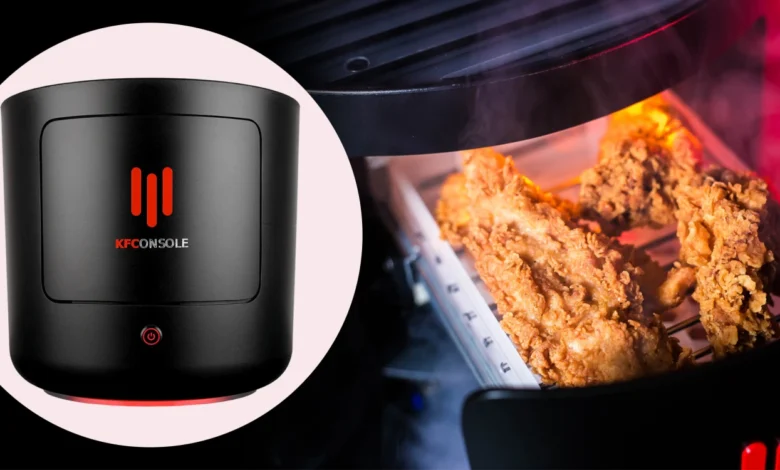KFC Console: The Gaming Machine That Surprised the World

When you hear “KFC,” the first thing that comes to mind is probably a bucket of fried chicken, not a gaming console. But in late 2020, the world was introduced to something so unexpected that it almost sounded like a joke: the KFC Console. Yes, you read that right—Kentucky Fried Chicken, the global fast-food chain, announced its very own gaming console that not only plays games but also keeps your fried chicken warm while you play. It was part marketing stunt, part tech innovation, and completely unforgettable.
The KFC Console quickly went viral because it blended two things people love: gaming and food. On the surface, it might seem like just a funny idea, but when you dig deeper, it becomes clear that the console was actually a pretty serious piece of technology. With gaming partnerships and real hardware specifications, it wasn’t just a gimmick—it was a bold statement about how brands can push boundaries.
So, let’s dive into the fascinating world of the KFC Console: what it is, why it was created, and why people are still talking about it years later.
The Origins of the KFC Console
The story of the KFC Console began in 2020, a year filled with unusual events that reshaped industries and lifestyles across the globe. In the middle of new gaming hardware releases like the PlayStation 5 and Xbox Series X, KFC shocked fans by announcing their own entry into the gaming market. At first, many thought it was an internet hoax or a clever April Fool’s prank, but KFC confirmed that the project was real.
The concept was developed in collaboration with Cooler Master, a well-known name in the PC gaming hardware world. Unlike traditional consoles, the KFC Console was essentially a high-performance gaming PC built inside a unique design that included a “chicken chamber”—a space that uses the system’s heat to keep fried chicken warm. The combination of serious gaming capabilities and a playful food tie-in made it stand out immediately.
For KFC, this was more than just a quirky idea—it was a brand statement. The company had already built a reputation for clever marketing campaigns that leaned into humor and creativity, and the console was an extension of that. Instead of sticking to traditional advertising, KFC tapped into the massive gaming community and created something that felt both hilarious and innovative.
What Makes the KFC Console Special?

At its core, the KFC Console wasn’t just about fried chicken; it was about showing off some serious tech. While most people laughed at the chicken-warmer gimmick, the actual specifications of the console were surprisingly impressive. The KFC Console was said to feature an Intel Nuc 9 Extreme Compute Element, which gave it high processing power, making it capable of running the latest PC games at smooth frame rates.
Another highlight was the inclusion of ray tracing and support for VR gaming, something that put it on par with high-end gaming PCs. It also boasted a hot-swappable GPU slot, which meant players could upgrade their graphics card as newer models were released. That was a feature even some mainstream consoles didn’t offer.
But, of course, the real star of the show was the “Chicken Chamber.” Using heat and airflow from the console’s system, the chamber could keep your food warm while you gamed. It wasn’t exactly a kitchen appliance, but the innovation was clever—it took a problem (wasted heat from gaming PCs) and turned it into a funny, practical feature.
Marketing Genius or Just a Gimmick?
One of the most debated questions about the KFC Console is whether it was ever intended to be taken seriously. Was it a fully functional gaming machine that could compete with giants like Sony and Microsoft, or was it just a flashy marketing campaign designed to go viral?
The truth probably lies somewhere in between. On one hand, the hardware was real, and KFC did partner with serious tech companies to bring the concept to life. That means the console wasn’t just a mock-up—it was an actual working system. On the other hand, its availability was extremely limited, and it never reached mass-market production. That suggests it was less about competing in the gaming industry and more about creating buzz.
From a marketing standpoint, it was a stroke of genius. The KFC Console generated massive online conversations, earned media coverage across tech and gaming outlets, and positioned KFC as a brand willing to take risks and have fun. Instead of spending millions on traditional ads, they created a viral sensation that people still talk about years later.
The Reaction from Gamers and Tech Enthusiasts
When the KFC Console was first announced, the internet exploded with reactions. Gamers were fascinated, tech enthusiasts were intrigued, and casual fans were simply amused. Memes spread like wildfire, with jokes about greasy controllers, chicken-powered gaming, and fast-food-inspired esports leagues.
But beyond the humor, many in the gaming community appreciated the boldness of the idea. After all, gaming has always been about creativity and pushing boundaries, and the KFC Console embodied that spirit in a unique way. For PC builders and hardware enthusiasts, the specs were nothing to laugh at—the console was actually a powerful mini-PC that could rival mainstream gaming rigs.
Some skeptics dismissed it as a gimmick, pointing out that very few people would actually use the chicken chamber seriously. Others, however, saw it as a fun way to merge two aspects of modern culture: gaming and fast food. Either way, the KFC Console succeeded in getting people talking, and that was the ultimate goal.
The Legacy of the KFC Console
Even though the KFC Console never became a mainstream product, its legacy lives on as one of the most creative and memorable brand experiments in recent history. It showed that companies outside of the gaming industry could still make an impact by tapping into gamer culture in smart, humorous ways.
For KFC, it was proof that their marketing team understood how to grab attention in the digital age. Instead of competing directly with Sony, Microsoft, or Nintendo, they created something unexpected and playful, which resonated with audiences worldwide. In a year where the world needed distractions, the KFC Console was the perfect mix of laughter and curiosity.
Interestingly, the KFC Console also sparked conversations about the future of brand collaborations in gaming. If a fast-food chain could partner with a tech company to make a gaming console, what else was possible? Could we see more unconventional brands entering the space with creative projects? The KFC Console opened the door to those possibilities.
Why the KFC Console Still Matters Today
Years after its debut, the KFC Console remains a cultural touchstone. It might not be on store shelves or competing in sales charts, but it continues to be referenced in gaming discussions, marketing case studies, and internet humor. In many ways, it has become a legend—a reminder that sometimes the wildest ideas can create the biggest impact.
For gamers, it was a fun distraction that showed the lighter side of the industry. For marketers, it was a case study in how to create viral campaigns that blur the line between product and stunt. And for KFC, it was another chapter in their long history of playful, out-of-the-box advertising.
The KFC Console may not have changed the gaming industry, but it definitely left its mark. And that’s more than many products can say.
Final Thoughts
The KFC Console will go down as one of the quirkiest, boldest, and most entertaining experiments in gaming history. Whether you see it as a genuine piece of hardware or a clever marketing stunt, there’s no denying the creativity and innovation behind it. By merging two worlds—gaming and fried chicken—KFC created something unforgettable.
At the end of the day, the console wasn’t just about keeping your chicken warm or running high-end games; it was about proving that brands can break out of their comfort zones and create something extraordinary. And in doing so, KFC reminded us that sometimes, the best way to make an impact is to surprise people with something they never thought they needed—but suddenly can’t stop talking about



